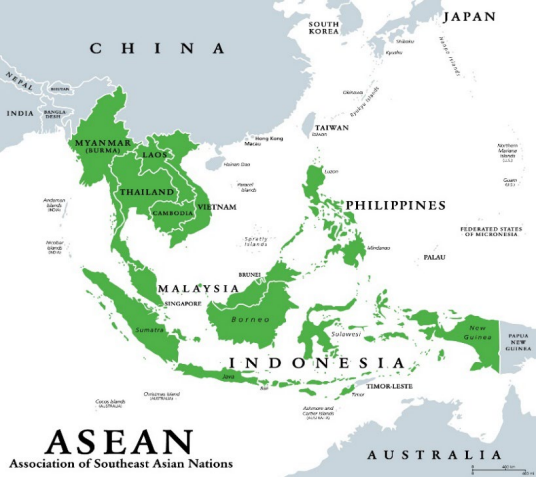The second Trump presidency brings with it both continuity and change. Many of the trends shaping global trade today began during his first term, particularly the shift in supply chains, which have been fragmenting since 2016. The trade war with China, coupled with the disruption caused by COVID-19, highlighted the risks of concentrated, “just-in-time” supply chains. Geopolitical tensions in recent years have reinforced this shift. As a result, companies started diversifying production to reduce vulnerabilities, moving toward an alternative “just-in-case” approach. Trump’s return to office means this momentum is likely to continue. For ASEAN countries, despite the uncertainty, this also presents an opportunity.
Chart 1: ASEAN (Association of Southeast Asian Nations)

Source: Shutterstock
For example, many ASEAN nations are now credible alternatives to China for manufacturing. Vietnam’s proximity to Shenzhen, for example, makes it a convenient production hub. Malaysia has long-standing tech ecosystems, some even predating China’s rise as a manufacturing powerhouse. And beyond the China-plus-one strategy, businesses are also considering a “Taiwan-plus-one” approach, as geopolitical risks drive companies heavily dependent on Taiwan-based tech suppliers, for example, to diversify.
Trump’s hopes of reshoring manufacturing jobs are limited, ASEAN to benefit
Despite the threat of Trump’s protectionist policies, large-scale reshoring of manufacturing to the US remains an unlikely outcome, in our view. Infrastructure constraints and cost differences mean only high-value sectors, such as semiconductors or electric vehicles, might see some onshoring. Most production will continue to seek the lowest-cost locations, after factoring tariffs and trade policies. If ASEAN enjoys a tariff advantage over China, it could attract even more investment, reinforcing its role as a key manufacturing hub. If only a fraction of China’s manufacturing base continues to shift to ASEAN, the positive economic impact is significant.
The possibility of higher tariffs directed at ASEAN countries remains unclear. While Trump has focused on Mexico, Canada and China, Vietnam has also attracted some attention due to its growing trade surplus with the US. However, any tariffs imposed on ASEAN nations would likely be lower than those targeting China, given the US-China trade rivalry. This could create a relative advantage for ASEAN manufacturers, encouraging further investment in the region.
The inflationary and interest rate impact on ASEAN
Aside from tariffs and trade wars, the second Trump presidency has sparked fresh uncertainties around inflation and interest rates. Initially, markets had been expecting a more benign rate environment in 2025, with multiple rate cuts likely. However, towards the end of 2024, those expectations shifted, as concerns grew that Trump’s policies would lead to a less accommodative stance from the US Federal Reserve.
A “higher-for-longer” rate environment will affect ASEAN economies in different ways. Those more reliant on external funding, particularly those with significant US dollar-denominated debt, will be more vulnerable to higher interest rates. Indonesia, the Philippines, and Vietnam fall into this category and underperformed in late 2024 as rate cut expectations faded. In contrast, Singapore benefited from higher rates, as its banking sector, which is an index heavyweight, enjoyed improved lending margins because of the very low cost of funds, boosting its stock market performance.
So, last year’s expected tailwind has tilted towards a more hawkish rate environment than originally anticipated. However, there are signs the environment may not be as severe as feared. The US dollar has softened slightly in early 2025, hinting at a marginal shift in sentiment. Additionally, it is worth noting that not all of the Trump administration’s policies are inflationary. If he moves to end ongoing wars or implements swingeing government spending cuts, these could have a pronounced disinflationary effect. Therefore, should rate pressures ease, the underperformance of externally-funded ASEAN economies may reverse, while Singapore, which thrived on higher rates, could see relative underperformance. All we can say with certainty at this stage is that the situation remains fluid, with the worldview evolving and changing very quickly.
ASEAN’s balancing act between the US and China
ASEAN countries have long navigated the complex relationship between the US and China, and that balancing act is set to continue. Despite growing geopolitical tensions, most ASEAN nations are unlikely to be forced into choosing one side outright. Instead, they will maintain a pragmatic approach, aligning with each power on different issues that best serve their national interests.
Singapore is a prime example. Its economic ties are divided, with stronger manufacturing and trade links with China, while financial services and technology sectors have deeper connections with the US. This strategy extends across much of ASEAN. Countries like Vietnam have a long history of skilfully managing great-power dynamics, leveraging both US and Chinese engagement for their economic and strategic benefit. Malaysia, Indonesia, and Thailand also seek to maximise their interests without fully committing to one bloc or the other.
There are exceptions. Laos and Cambodia are far more dependent on China and are unlikely to deviate from that alignment. But for the region as a whole, the ability to “walk the tightrope” remains a key strength. ASEAN nations have proven adept at navigating shifting global alliances, and as the rivalry between the US and China evolves, they will look to continue this delicate balancing act to their advantage.
Our bottom-up approach to investing in ASEAN
While many investors are wondering how Trump’s policies will shape global markets and are looking to allocate assets accordingly, we remain committed to a bottom-up investment approach. Rather than making broad calls on macroeconomic trends, we continue to prioritise investing in companies with strong fundamentals, high sustainable returns and positive structural change. While we maintain a view on macro developments, stock selection ultimately drives investment decisions. The ongoing shift in global supply chains, for example, is seen as a long-term structural trend, and we seek companies positioned to benefit from it.
For example, the supply chain bifurcation we’ve outlined extends beyond traditional manufacturing to data infrastructure. The global technology landscape is increasingly bifurcated, with separate data ecosystems emerging inside and outside of China. The development of artificial intelligence (AI) follows a similar pattern, with distinct regional domains. This has driven a growing emphasis on data sovereignty, as governments push for localised data storage and infrastructure. Malaysia and Thailand are seeing increased investment in data centres, helped by their abundant energy resources, which are essential for powering data facilities. As a result, we are attracted to companies involved in building, operating, or supplying land for data centres, including a Malaysian firm that recently secured the country’s largest-ever land deal with Microsoft.
Beyond technology, there are attractive opportunities in sectors that offer resilience in an uncertain economic environment. Consumer staples in Indonesia are particularly attractive, as companies benefit from strong pricing power and lower input costs, leading to growing margins. The healthcare sector presents a similar opportunity, with Thai hospital operators supported by medical tourism and domestic healthcare reforms.
Supportive government policies are also shaping investment opportunities. Singapore recently introduced new incentives to attract fund managers and investment capital. Meanwhile, economic cooperation between Singapore and Malaysia is strengthening, culminating in the launch of the Johor-Singapore Special Economic Zone (JS-SEZ) in January 2025. This agreement is expected to drive high-value investment in manufacturing, tourism, renewable energy and logistics, further integrating Johor into Singapore’s business ecosystem. With upcoming elections in Singapore (this year) and Malaysia (in two or three years), both relatively new governments have strong political incentives to deliver tangible economic growth.
Vietnam is another market to watch. Its new leadership is expected to take a more pragmatic, business-friendly approach, in contrast to the previous administration’s more ideological stance. This could create further investment opportunities as policy shifts encourage economic growth.
While Trump’s trade policies will continue to influence global markets, they do not dictate stock selection. We remain focused on identifying companies that can thrive regardless of the macroeconomic backdrop, ensuring that investment decisions are driven by long-term fundamentals rather than short-term political shifts. Overall, the ASEAN region presents a wealth of long-term investment opportunities, driven by strong fundamentals and supportive policies, making it a compelling destination for investors seeking growth and resilience in these uncertain times.
If you have any questions on this report, please contact:
Nikko AM team in Europe
Email:
This email address is being protected from spambots. You need JavaScript enabled to view it.




